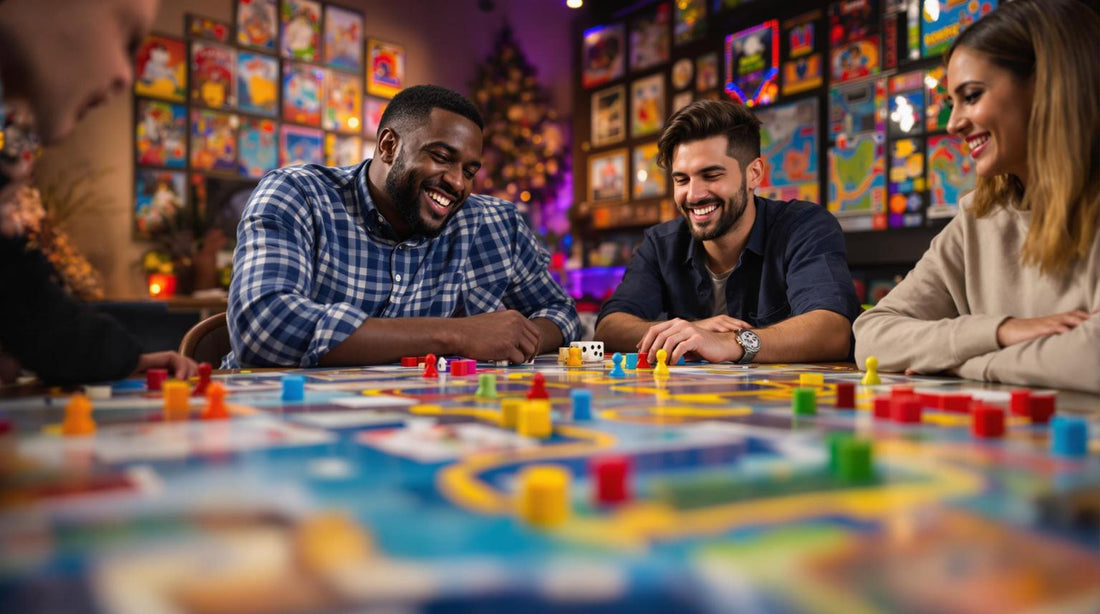Discover the Best Board Games for Every Player

How to Choose the Right Venue for Board Game Events
Choosing the right venue is crucial for a successful board game event. The venue impacts comfort, accessibility, and overall experience. Here’s a quick guide to get started:
- Plan for Space: Estimate attendance (20–200 people) and allocate 15–35 sq ft per person based on event type (casual, tournament, mixed).
- Check Facilities: Ensure proper lighting, sound control, climate control, restrooms, power outlets, Wi-Fi, and secure storage.
- Focus on Accessibility: Look for wheelchair access, parking, public transit, and emergency exits.
- Set the Atmosphere: Choose a venue that matches your event’s theme and supports smooth gameplay.
Quick Venue Checklist
| Criteria | Key Features |
|---|---|
| Space | Enough room for tables, chairs, and movement. |
| Lighting | Adjustable lighting to reduce glare and improve visibility. |
| Sound | Good acoustics to ensure clear communication. |
| Location | Easy access via public transit and ample parking. |
| Facilities | Restrooms, food areas, storage, and reliable Wi-Fi. |
| Cost | Fits within your budget; check for hidden fees. |
Start by listing your event needs, research venues that meet your criteria, and confirm all details before booking. A well-chosen venue ensures a smooth and enjoyable event for all attendees.
Selecting a Venue for Your Event
Step 1: List Your Event Requirements
Before diving into venue options, figure out exactly what your event needs. This ensures the space you choose fits the bill.
Calculate Event Size and Type
The type of event you're hosting has a big impact on the kind of space you'll need. A casual game night won't require the same setup as a tournament or launch party. Here are some things to consider:
- Attendance Numbers: Estimate how many people will join. For local events, this often ranges from 20 to 200 attendees.
- Space per Player: Plan for 15–20 square feet per person. This allows room for gaming tables, chairs, and movement.
- Duration: Decide if it's a single-day event or if it spans several days.
Identify Required Facilities
Make sure the venue has the right features to support your event. Here's a quick breakdown:
| Facility Type | What to Look For |
|---|---|
| Gaming Area | Bright lighting and table setups that work for your event. |
| Food & Beverage | Separate areas for eating to keep games safe. |
| Equipment | Ample power outlets, reliable Wi-Fi, and a PA system if needed. |
| Storage | Secure space for game inventory and supplies. |
| Restrooms | Multiple restrooms, including accessible ones. |
Check Access and Location
Accessibility is a must to make sure everyone can attend comfortably:
- Physical Access: Confirm the venue is wheelchair accessible.
- Transportation: Look for ample parking and nearby public transit options.
- Emergency Planning: Ensure clear and accessible emergency exits.
- Special Needs: Consider accommodations for attendees with hearing, visual, or neurodivergent needs.
This checklist will help you find a venue that balances comfort, accessibility, and functionality - all within your budget. Once you've nailed down these details, start researching venues that match your criteria.
Step 2: Research Available Venues
Once you've outlined your event's needs, it's time to find the right venue. Focus on factors like accessibility, space, and the overall setting.
Check Location and Transportation
A venue's location can make or break attendance. To ensure convenience, look for places that offer:
- Multiple public transit options near major hubs
- Plenty of on-street and off-street parking
- Easy walking access to transit stops (within 10–15 minutes)
Evaluate Space and Layout
The venue's layout plays a big role in creating a comfortable gaming experience. Estimate how much space you'll need based on your event activities:
| Activity Type | Space Needed Per Person |
|---|---|
| Standard Gaming Tables | 22–25 sq ft |
| Tournament Setup | 30–35 sq ft |
| Mixed Gaming Areas | 25–30 sq ft |
When assessing the space:
- Use a laser measurement tool for accurate dimensions.
- Take note of any fixed obstacles like columns or built-in furniture.
- Check if modular furniture can be rearranged to suit your setup.
Finally, make sure the room's environment aligns with your event's requirements.
Inspect Room Environment
-
Lighting
Look for adjustable lighting options to reduce eye strain and improve gameplay. Ideal setups include overhead lighting, task lighting for tables, and indirect lighting to cut down on glare. -
Sound
Test the acoustics to ensure sound doesn't echo or reflect excessively. Clear communication among players is essential. -
Temperature
Confirm that the venue has reliable climate control, adjustable thermostats, and proper ventilation to keep everyone comfortable, especially during large gatherings.
sbb-itb-1ed942f
Step 3: Design Your Game Space
Once your venue is confirmed, it’s time to design your gaming space for both fun and functionality.
Plan Table Layout
A well-thought-out table layout is key to smooth gameplay. Dedicate specific areas to different game types. Choose table sizes and setups that work for standard board games, larger strategy games, and card games. Don’t forget to ensure easy access to power outlets for games with electronic components.
Check Light and Sound Quality
Good lighting and sound can make or break the gaming experience. Here's how to get it right:
- Primary Lighting: Use overhead lights that reflect off walls and ceilings to minimize glare. Opt for daylight-equivalent bulbs for natural brightness.
- Task Lighting: Add adjustable lamps to light up game boards without casting shadows.
- Ambient Lighting: Dimmable floor lamps can help set the mood and reduce eye strain.
For sound, focus on keeping the noise level at the tables manageable so players can communicate easily.
Plan Storage Areas
Keep your gaming space organized with smart storage solutions:
- Game Library: Store games vertically for easy access, and use labeled containers for frequently played games.
- Playing Area Storage: Place storage near tables, use wheeled tables for flexibility, and include systems to organize game components.
Set up a refreshment zone away from the gaming tables, complete with sideboards and cleanup stations to keep the area neat.
Step 4: Book Your Venue
Once your game space design is complete, it's time to lock in your venue.
Evaluate Your Options
Use a simple 1–5 scoring system to compare venues. Consider these key factors:
- Location & Access: Is it close to public transit? Is there enough parking?
- Space & Layout: Does it have enough square footage? Can tables be arranged as needed?
- Facilities: Are restrooms, storage, and power outlets easily accessible?
- Environment: How's the lighting, sound quality, and ventilation?
- Cost & Value: What’s the rental fee, and what amenities are included?
Pay extra attention to gaming-specific needs like lighting and table setups. These scores will help you decide which venue is the best fit.
Confirm Your Reservation
Once you’ve chosen a venue, carefully review the contract. Look out for:
- Deposit requirements, payment schedules, and cancellation policies
- Insurance needs
- Setup and breakdown time allowances
- Capacity limits
Double-check that the venue’s features match your event’s needs. Verify responsibilities for tasks like table setup, equipment handling, cleaning, and security. Don’t forget to confirm emergency procedures.
Plan Your Setup
A clear setup plan will help things run smoothly. Include these details:
- Floor Plan: Map out where game stations, refreshment areas, storage spaces, and emergency exits will be. Consider how attendees will move through the space.
- Setup Timeline: Note when you’ll have access to the venue and outline tasks like arranging tables and chairs, setting up the game library, placing signage, and testing equipment.
- Staff Instructions: Assign roles to venue staff and volunteers. Include emergency procedures and clean-up tasks so everyone knows their responsibilities.
This preparation ensures your event is ready for a great start.
Conclusion: Next Steps for Your Gaming Event
With your venue secured, it’s time to dive into planning an unforgettable gaming event. Start by revisiting your venue checklist 8–12 months ahead to make sure no detail slips through the cracks.
Once the venue is locked in, shift your attention to pre-event preparations that set the stage for success.
Key Pre-Event Tasks
- Design a floor plan that maps out game stations and ensures smooth traffic flow.
- Develop an hourly setup schedule to keep everything on track.
- Assign clear roles to staff and volunteers to streamline operations.
- Test all technical equipment - from lighting to gaming consoles - well in advance.
- Draft emergency procedures to handle unexpected situations effectively.
When choosing games, consider how they fit with your venue’s layout and timing. For example, Brain Games offers a wide selection suited for different gaming preferences.
Pro Tip: Stock up on extra copies of popular games to cut down on wait times.
If storage is tight, prioritize games with smaller packaging and arrange tables to accommodate both strategy and party games without overcrowding.
Final Venue Coordination
Reach out to your venue coordinator at least a month before the event to:
- Double-check all booking details.
- Go over your setup timeline together.
- Confirm any insurance requirements.
- Schedule a final walkthrough to ensure everything is in place.
Careful preparation like this will help your gaming event run smoothly and keep participants engaged from start to finish.






